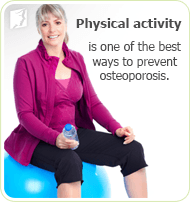The best way to avoid the painful and debilitating bone fractures that can come with osteoporosis is to prevent the disease before it takes hold. While taking preventative measures as a young adult is the best course of action, there are still ways to increase bone mass - or at least limit the rapid deterioration of bones common in menopausal women - before osteoporosis becomes a problem. Continue reading to learn more about osteoporosis prevention methods.
Osteoporosis Prevention Tips
As mentioned above, the best time to take steps to prevent osteoporosis is in the teenage and young adult years. This is the time when adequate calcium intake is vital to the formation of healthy, strong bones. About 99% of the body's calcium is stored in the bones and teeth, making it essentially the building blocks of bones. It's never too late to begin consuming adequate amounts of calcium to prevent osteoporosis. As a woman gets older, the amount of calcium she requires per day increases. The recommended amount of calcium depending on age is listed below.
- 1 - 3 years old: 500 mg per day
- 4 - 8 years old: 800 mg per day
- 9 - 18 years old: 1,300 mg per day
- 19 - 50 years old: 1,000 mg per day
- 51 and older: 1,200 mg per day
Vitamin D is also crucial for healthy bones. Vitamin D aids the absorption of calcium in the bones, so a deficiency can contribute to osteoporosis. Below are the recommended amounts of vitamin D that a person should get each day depending on age.
- Ages 19 - 50: 5 μg (200 IU)
- Ages 51 - 70: 10 μg (400 IU)
- Age 71 and older: 15 μg (600 IU)

Adequate physical activity is also crucial for osteoporosis prevention. Weight-bearing exercise - such as walking, jogging, jumping, stair climbing, push-ups, and other forms of exercise that forces the bones and muscle to support weight - help to keep bones dense and strong. Weightlifting can also create strong bones and prevent osteoporosis.
Avoiding alcohol can be an important aspect in sidestepping osteoporosis. Excessive alcohol consumption can kill the cells that rebuild bones. It can also limit the amount of estrogen in the body, which also deteriorates the bones and leads to osteoporosis.
Statistics
Smoking can also decrease the body's ability to absorb calcium. Avoiding smoking can be a key aspect of preventing osteoporosis.
It's also important to maintain a healthy body weight and not skip meals or lose too much weight later in life. Weight loss almost surely signifies a loss of bone mass, which puts the individual at risk of developing osteoporosis.
Read below to learn ways to prevent falls, which is the way most osteoporotic fractures occur.
Preventing Falls
Falls at any age or state of health can be dangerous and lead to fractured bones. However, a person with osteoporosis is especially at risk of breaking bones from falling because the bones are so much weaker that non-osteoporotic bones.
Because most falls that lead to bone fractures take place in a woman's home, it's important to make the home as safe as possible and eliminate possible risk factors. Here are some steps that can make a house safer for someone with osteoporosis:
Did You Know?
- More than 90% of hip fractures are associated with osteoporosis.
- Nine out of ten hip fractures in older Americans are the result of a fall.
- Individuals who have a hip fracture are 5 - 20% more likely to die in the first year following that injury than others in this age group.
- Most falls happen to women in their homes in the afternoon.
- Wear appropriate, flat shoes
- Wear glasses with the correct prescription and have this checked regularly
- Avoid having loose rugs and carpets or trailing electrical flexes
- Repair any torn floor coverings
- Make sure the home is well lit
- Be extra careful when taking medicines, especially sleeping pills and sedatives that may cause drowsiness, making a person more likely to trip or stumble
- Anyone who experiences dizziness or is at risk of falling should talk to their doctor about how their medications might affect this
- Anyone who needs to get up during the night to use the bathroom should leave some lights on where possible and make sure the route from the bed to the toilet is safe and clear of items that could cause a fall
Prevention is the best way to avoid osteoporosis, but if the disease has already set in, prevention is too late. Click on the following link to learn more about treatments for osteoporosis.
Sources
- Christenson, E.S. et al. (2012). Osteoporosis management in post-menopausal women. Minerva Ginecologica, 64(3), 181-194. Retrieved from http://www.ncbi.nlm.nih.gov/pubmed/22635014
- Cleveland Clinic. (n.d.). Menopause and Osteoporosis. Retrieved May 10, 2016, from https://my.clevelandclinic.org/health/diseases_conditions/hic-what-is-perimenopause-menopause-postmenopause/hic_Menopause_and_Osteoporosis
- New York State Department of Health. (2015). Calcium and Healthy Bones. Retrieved May 10, 2016, from https://www.health.ny.gov/publications/1982.pdf
- Office on Women's Health. (2012). Osteoporosis fact sheet. Retrieved May 10, 2016, from http://www.womenshealth.gov/publications/our-publications/fact-sheet/osteoporosis.html
- University of Maryland Medical Center. (2015). Osteoporosis. Retrieved May 10, 2016, from http://umm.edu/health/medical/altmed/condition/osteoporosis
- U.S. Department of Health and Human Services. (n.d.). 18 Ways Smoking Affects Your Health. Retrieved May 10, 2016, from http://smokefree.gov/health-effects


